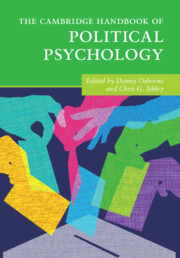Book contents
- The Cambridge Handbook of Political Psychology
- The Cambridge Handbook of Political Psychology
- Copyright page
- Dedication
- Contents
- Figures
- Tables
- Contributors
- Part I Foundations of Political Psychology
- 1 Political Psychology
- 2 The Evolutionary Basis of Political Ideology
- 3 Genetic Contributions to Political Phenomena
- 4 The Psychology and Neuroscience of Partisanship
- 5 The Personality Basis of Political Preferences
- 6 The Structure, Prevalence, and Nature of Mass Belief Systems
- 7 The Psychology of Public Opinion
- 8 Rational Choice and Information Processing
- 9 Emotions and Politics
- 10 The Developmental Science of Politics
- Part II The Politics of Intergroup Attitudes
- Part III Contemporary Challenges to Democracy
- Part IV Diversifying Perspectives in Political Psychology
- Index
- References
9 - Emotions and Politics
from Part I - Foundations of Political Psychology
Published online by Cambridge University Press: 17 February 2022
- The Cambridge Handbook of Political Psychology
- The Cambridge Handbook of Political Psychology
- Copyright page
- Dedication
- Contents
- Figures
- Tables
- Contributors
- Part I Foundations of Political Psychology
- 1 Political Psychology
- 2 The Evolutionary Basis of Political Ideology
- 3 Genetic Contributions to Political Phenomena
- 4 The Psychology and Neuroscience of Partisanship
- 5 The Personality Basis of Political Preferences
- 6 The Structure, Prevalence, and Nature of Mass Belief Systems
- 7 The Psychology of Public Opinion
- 8 Rational Choice and Information Processing
- 9 Emotions and Politics
- 10 The Developmental Science of Politics
- Part II The Politics of Intergroup Attitudes
- Part III Contemporary Challenges to Democracy
- Part IV Diversifying Perspectives in Political Psychology
- Index
- References
Summary
This chapter surveys recent research about the effects of discrete emotions in politics and international relations. We first examine the appraisal theory of emotions in psychology and discuss its categorisation of contacting, distancing, attack, and rejection emotions. Next, we review Affective Intelligence Theory (AIT) and its impact on the study of political psychology. For the remainder of the chapter, we discuss the basic traits and general effects of the most important emotions in politics: anger, anxiety, contempt, disgust, enthusiasm, fear, guilt, hope, and shame. Topics from recent studies are highlighted for each emotion, including political participation, public opinion, social media, ideology, partisanship, gender, race, political extremism, nationalism/national identity, foreign policy, authoritarianism, immigration, populism, human rights, terrorism, and security studies. Finally, the chapter closes with a brief look at two group-orientated perspectives on emotions: moral emotions and collective emotions.
- Type
- Chapter
- Information
- The Cambridge Handbook of Political Psychology , pp. 139 - 158Publisher: Cambridge University PressPrint publication year: 2022
References
- 4
- Cited by



